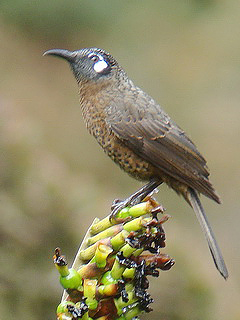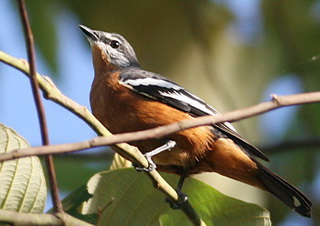
Myza sarasinorum
TAXONOMY
Myza sarasinorum Meyer and Wiglesworth, 1895, Matinan
Mountains, north Celebes (Sulawesi).
OTHER COMMON NAMES
English: White-eared myza, greater streaked honeyeater, spotheaded
honeyeater; French: Mйliphage а points; German: Sarasinhonigfresser;
Spanish: Pбjaro Azъcar de Cabeza Moteada.
PHYSICAL CHARACTERISTICS
8 in (20 cm); weight about 1 oz (30 g). Long body and long,
decurved bill. Head black with pinkish white patch behind eye.
Rufous from chin to vent, with breast and back mottled rufous
brown. Brown rump and tail.
DISTRIBUTION
Sulawesi, with separate subspecies in northern, central, and
southeastern parts of the island.
HABITAT
Montane and elfin moss forest, at 5,000–8,500 ft (1,700–2,800 m).
BEHAVIOR
Occur singly or in pairs, active and pugnacious. Described as
squirrel-like in the way that they scurry about the branches of
moss-draped trees. Wide variety of calls, including zunk, kep,
kik, kuik, zip, and tuck. Also emit a high-pitched squeaky song.
FEEDING ECOLOGY AND DIET
Forage from the understory to the treetops, taking arthropods
from epiphytes and probing flowers, especially flowers of
gingers.
REPRODUCTIVE BIOLOGY
Not known.
CONSERVATION STATUS
Not threatened. Common in suitable habitat.
SIGNIFICANCE TO HUMANS
None known.
Other popular Animals
Photo Gallery of - Greater Sulawesi honeyeater




 Animalia Life
Animalia Life